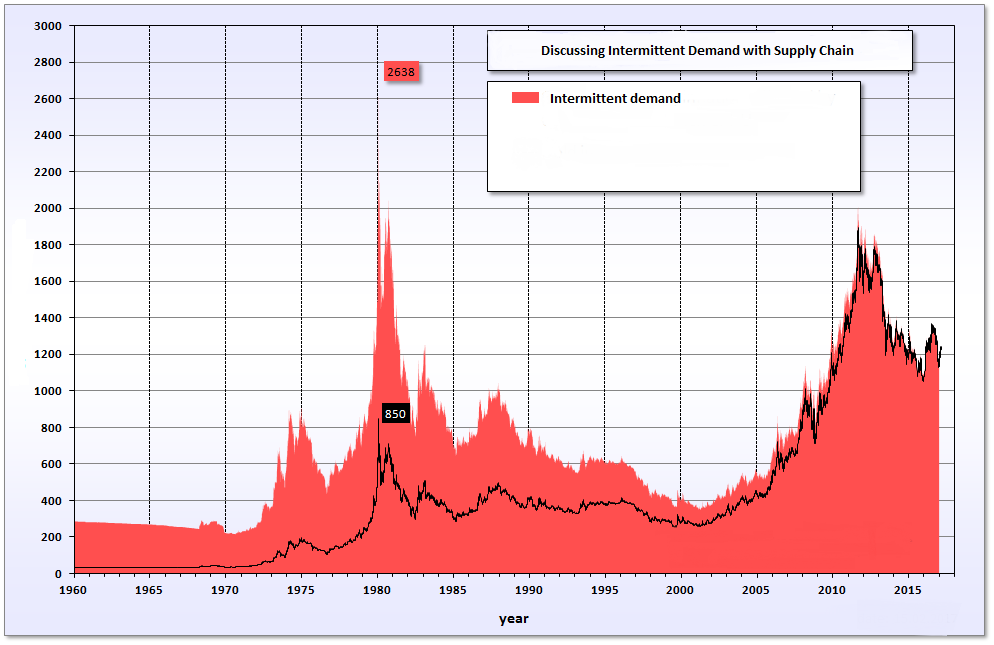The unique challenges of inventory planning for spare parts, large capital goods and other infrequently or irregularly moving items drives the importance of finding smarter methods to forecast this kind of intermittent demand. Robert Bowman, Editor of Supply Chain Brain Magazine, and I discussed this topic at the October APICS conference in Denver, and video of our conversation is available at Supply Chain Brain‘s website.
Why plan for intermittent demand? Well, why plan for any demand? If you can understand what the likely range of demand will be until you can get more, you will know how much stock to keep in reserve, so you have just enough. This is the heart of demand forecasting and inventory optimization. Intermittent demand is exceptionally difficult to forecast, but this same principle holds true.
Unlike other demand patterns, where historical data suggests regular trends, ebbs and flows, seasonality or other discernible patterns, intermittent demand appears to be random. There are many periods of zero demand interspersed with irregular, non-zero demand. This occurs frequently with service parts, where parts are replaced when they break, and you just don’t know when that will occur. Most service parts inventories (70% or more!) can experience intermittent demand. Demand for specialized or configured products is also likely to be intermittent.
Supply Chain Brain has made the more in-depth discussion of this topic Bowman and I shared available here. For new visitors to Supply Chain Brain, a quick account sign-up is required to access the video.
Jeff Scott serves as Vice President, Marketing & Alliances for Smart Software.
Related Posts

Managing Spare Parts Inventory: Best Practices
In this blog, we’ll explore several effective strategies for managing spare parts inventory, emphasizing the importance of optimizing stock levels, maintaining service levels, and using smart tools to aid in decision-making. Managing spare parts inventory is a critical component for businesses that depend on equipment uptime and service reliability. Unlike regular inventory items, spare parts often have unpredictable demand patterns, making them more challenging to manage effectively. An efficient spare parts inventory management system helps prevent stockouts that can lead to operational downtime and costly delays while also avoiding overstocking that unnecessarily ties up capital and increases holding costs.

Innovating the OEM Aftermarket with AI-Driven Inventory Optimization
The aftermarket sector provides OEMs with a decisive advantage by offering a steady revenue stream and fostering customer loyalty through the reliable and timely delivery of service parts. However, managing inventory and forecasting demand in the aftermarket is fraught with challenges, including unpredictable demand patterns, vast product ranges, and the necessity for quick turnarounds. Traditional methods often fall short due to the complexity and variability of demand in the aftermarket. The latest technologies can analyze large datasets to predict future demand more accurately and optimize inventory levels, leading to better service and lower costs.

Future-Proofing Utilities: Advanced Analytics for Supply Chain Optimization
Utilities in the electrical, natural gas, urban water, and telecommunications fields are all asset-intensive and reliant on physical infrastructure that must be properly maintained, updated, and upgraded over time. Maximizing asset uptime and the reliability of physical infrastructure demands effective inventory management, spare parts forecasting, and supplier management. A utility that executes these processes effectively will outperform its peers, provide better returns for its investors and higher service levels for its customers, while reducing its environmental impact.











